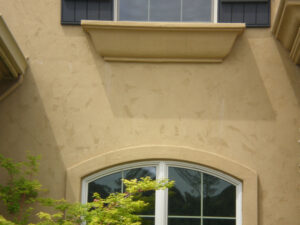Stucco Philadelphia is a beautiful siding option that adds character and curb appeal to your home. It’s easy to clean and is highly durable. However, you need to inspect it regularly and repair cracks as they occur.

Stucco is a composite material that naturally deters fire, mold, rot and termite infestations. It also resists moisture and requires low annual maintenance costs.
Stucco is an extremely durable material that can be used in many different ways. It can be applied smooth or rough and it can be textured in a number of different ways, allowing you to create a truly unique look. Stucco is also easy to maintain, with regular pressure washing being enough to keep it looking good. It is also highly cost effective, making it an excellent choice for homeowners who want to increase the value of their homes.
Although stucco is known for its durability, it can be damaged by improper installation and care. Cracks, discoloration and deterioration of stucco can result from poor lathing, insufficient control joints and inadequate reinforcement. These problems can be prevented by hiring a professional who is familiar with stucco application and maintenance techniques.
One of the most important aspects of maintaining stucco is to ensure that it is properly waterproofed. While this may seem like a straightforward task, it is vital to make sure that all areas of the stucco are fully watertight. Otherwise, the interior of the home can be flooded and the structure can be damaged.
A poorly waterproofed exterior can also allow moisture, insects and rodents to enter the home. This can cause serious damage to the stucco and other components of the building. If the problem isn’t fixed immediately, it can lead to a costly repair bill.
Unlike other siding options, stucco can last over 50 years with proper maintenance. It is also resistant to mold, rot and mildew. It can also be painted to match your home’s colour scheme and is aesthetically pleasing. In addition, stucco is easier to clean than other types of siding, with a simple low-pressure spray from a garden hose being sufficient.
Easy to colour
While most people think of stucco as a subdued gray or white color, pigments are available in a variety of colors to make the material more vibrant. Some of these brighter options include green, yellow, and blue. The process for adding these colors to the stucco mix is fairly simple, but there are a few things that you should keep in mind to ensure that the color is mixed evenly and fully incorporated into the stucco.
To start, determine how much powdered color you will need. Generally, manufacturers recommend using between 3% and 7% of the total stucco weight to achieve the desired color. This will vary depending on your personal preference and the overall look you want to create. A lower percentage will give you a more subdued color, while a higher percentage will help you achieve a more vibrant hue.
The next step is to add the pigment to the stucco mixture. This can be done either by mixing it with the sand or by using water to dilute it and create a paste-like consistency. The sand helps to grind down the pigment clumps and disperse them evenly, which will prevent the color from looking splotchy when applied to the surface of the house.
Once the color has been mixed, it is time to apply it to the brown coat of the stucco. This is an important step because it helps to strengthen the surface of the house and provide a layer of protection against the elements. In addition, this will also help the brown coat to adhere to the stucco and create a lasting bond.
You should wait at least 48 hours for the brown coat to dry before applying the final coat of stucco. During this time, it is important to keep the brown coat moist so that it does not crack prematurely. It is also important to clean the surface of the brown coat before applying the final coat.
A great way to add a pop of color to your home’s exterior is by painting the front door. This is a great way to showcase your personality and put a unique stamp on your home’s style. Just be sure to test a few paint swatches on your door before you decide on a color, and be sure to view the color at different times of the day.
Easy to customize
Stucco is a durable, low-cost finish that can add a natural, earth essence to your home. It can be applied to brick, wood frames, or concrete walls and is available in many pigments and textures. It can even be shaped to mimic different materials, such as brick or stone. Stucco also looks great on curved walls.
Unlike drywall, stucco can be manipulated and textured to give it a more unique look. This allows you to create a one-of-a-kind style that is perfect for your home. There are a number of different ways to do this, from thick texture to soft swirl patterns. In addition, you can tint the stucco to achieve a specific color or look.
Traditional stucco is applied in a three-coat process to wood-frame walls. The first coat, called the scratch coat, is spread over metal lath attached to a house’s exterior sheathing. This creates a rough surface that helps the next layer, the brown coat, adhere to the wall. The brown coat provides strength and acts as a base for the finish coat, which can be hand-troweled to create a custom surface texture.
To prevent cracking, you should install control joints every 18 ft (5.5 m) along the length of a wall. Also, make sure the sheathing is protected by a water-resistant barrier. If you use plywood, choose a water-resistant type and cover it with at least 2 layers of “Grade D” building paper or a dimpled rain screen. Avoid using plastic housewrap that is not designed for stucco, as it can rot and attract mold.
You should also protect the edges of the sheathing with flashing to keep moisture out. This is especially important in hot climates, where the stucco can easily rot if it gets wet. Finally, you should always use galvanized nails for stucco. Otherwise, the nails will rust and loosen over time.
If you’re considering stucco for your home, it’s important to hire a professional. Stucco is not a DIY project, and it requires special tools and expertise. It’s also a very time-consuming process, and it can be difficult to work in hot weather. If possible, try to start the job late in the day so that it can dry while it’s still cool. Also, make sure you clean your stucco regularly to remove dirt and debris.
Curb appeal
Stucco is a popular siding option that can give your home a unique decorative look. It can be tinted before it’s applied or painted with standard house paint to freshen up a faded color. There are many different shades of stucco available, from classic neutrals to earthy hues. Choosing the right shade can make your home stand out from the crowd and boost your curb appeal.
Unlike concrete, stucco is typically more of a decorative material that adds texture to the surface of your building. Stucco is also more durable, allowing it to withstand weather damage such as rain and sun exposure. It can be mixed with various additives to enhance its texture and appearance, such as sand, glass, or marble. Adding these elements can give your home a modern look that’s a step up from your neighbors.
It’s important to keep in mind that curb appeal isn’t just about the style of your house, but also how it matches with its surroundings. For example, if your stucco is dark, you can use an earthy shade of paint to lighten it up and complement the surrounding trees and shrubs. This will help to create a more unified and balanced look.
While it may seem like a minor detail, the right color can really make or break your home’s curb appeal. It’s important to purchase several samples before you settle on one. This is because the intensity of your chosen shade can vary significantly with shifting lighting conditions and exposure. For example, a soft mint green can turn into neon lime in full sunlight and over-ripe tangerine on a sunny south wall.
If you’re not sure how to choose a color, ask your local painting contractor to help you pick the best match for your home. They can show you sample colors and help you find the perfect hue for your exterior. They’ll also recommend the best type of paint to use on your stucco, such as acrylic because it’s breathable and won’t trap moisture that can lead to mold or deterioration.
Stucco is an ideal choice for your home’s exterior, but it’s not always easy to get the look you want. With the right paint and finishes, you can elevate your home’s exterior and create a great impression on guests and potential buyers.

